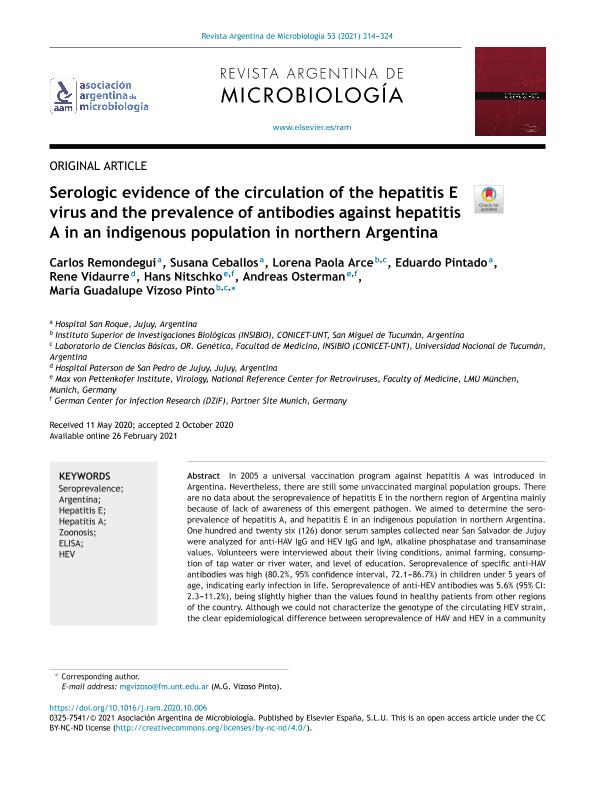Artículo
In 2005 a universal vaccination program against hepatitis A was introduced in Argentina. Nevertheless, there are still some unvaccinated marginal population groups. There are no data about the seroprevalence of hepatitis E in the northern region of Argentina mainly because of lack of awareness of this emergent pathogen. We aimed to determine the seroprevalence of hepatitis A, and hepatitis E in an indigenous population in northern Argentina. One hundred and twenty six (126) donor serum samples collected near San Salvador de Jujuy were analyzed for anti-HAV IgG and HEV IgG and IgM, alkaline phosphatase and transaminase values. Volunteers were interviewed about their living conditions, animal farming, consumption of tap water or river water, and level of education. Seroprevalence of specific anti-HAV antibodies was high (80.2%, 95% confidence interval, 72.1–86.7%) in children under 5 years of age, indicating early infection in life. Seroprevalence of anti-HEV antibodies was 5.6% (95% CI: 2.3–11.2%), being slightly higher than the values found in healthy patients from other regions of the country. Although we could not characterize the genotype of the circulating HEV strain, the clear epidemiological difference between seroprevalence of HAV and HEV in a community with poor sanitary conditions suggest that the circulating HEV strains spread through a different transmission route than HAV. Furthermore a significant correlation between anti-HEV IgG and swine farming was found (p < 0.05), which supports a zoonotic transmission path. We reassessed the epidemiological pattern of HAV infection and reported evidence of HEV infection for the first-time in a community belonging to the Guarani ethnic group, highlighting the need to include hepatitis E testing in routine diagnostics in the region. En 2005 se inició un programa de vacunación universal contra la hepatitis A en Argentina, pero todavía existen algunas poblaciones marginales no vacunadas. Además, los datos sobre la circulación de hepatitis E en el noroeste argentino son escasos. El objetivo de este trabajo fue determinar la seroprevalencia de la hepatitis A y la hepatitis E en una población autóctona del norte de Argentina. Se colectaron y analizaron 126 muestras de suero en habitantes de las yungas jujeñas; se determinaron transaminasas, fosfatasa alcalina y anticuerpos contra los virus de hepatitis A (HAV) (IgG) y hepatitis E (HEV) (IgG e IgM). Se obtuvieron los consentimientos informados y los voluntarios fueron entrevistados para identificar posibles factores de riesgo, como las condiciones de vida y la cría de animales, entre otros. La seroprevalencia de anticuerpos específicos anti-HAV fue alta (80,2%; intervalo de confianza [IC] 95%: 72,1-86,7%) en niños menores de 5 años, lo que indica infección temprana. La seroprevalencia de anticuerpos anti-HEV fue del 5,6% (IC 95%: 2,3-11,2%), ligeramente más alta que en otras regiones del país en pacientes sanos. Aunque no se caracterizó el genotipo circulante del HEV, la clara diferencia epidemiológica entre la seroprevalencia de ambos virus en una comunidad con malas condiciones sanitarias sugiere que la cepa circulante de HEV se transmite por una vía diferente que la del HAV. Además, encontramos una significativa correlación entre la cría de cerdo y la presencia de anticuerpos IgG anti-HEV (p < 0,05), lo que sugiere una vía de transmisión zoonótica. Reevaluamos el patrón epidemiológico de infección por el HAV y aportamos por primera vez una evidencia de infección por el HEV en una comunidad que pertenece a la etnia guaraní, por lo que destacamos la necesidad de incluir la detección de hepatitis E en la región.
Serologic evidence of the circulation of the hepatitis E virus and the prevalence of antibodies against hepatitis A in an indigenous population in northern Argentina
Título:
Evidencia serológica de la circulación del virus de la hepatitis E y prevalencia de anticuerpos contra la hepatitis A en una población indígena en el norte argentino
Remondegui, Carlos; Ceballos, Susana; Arce, Lorena Paola ; Pintado, Eduardo; Vidaurre, Rene; Nitschko, Hans; Osterman, Andreas; Vizoso Pinto, María Guadalupe
; Pintado, Eduardo; Vidaurre, Rene; Nitschko, Hans; Osterman, Andreas; Vizoso Pinto, María Guadalupe
 ; Pintado, Eduardo; Vidaurre, Rene; Nitschko, Hans; Osterman, Andreas; Vizoso Pinto, María Guadalupe
; Pintado, Eduardo; Vidaurre, Rene; Nitschko, Hans; Osterman, Andreas; Vizoso Pinto, María Guadalupe
Fecha de publicación:
10/2021
Editorial:
Asociación Argentina de Microbiología
Revista:
Revista Argentina de Microbiología
ISSN:
0325-7541
e-ISSN:
1851-7617
Idioma:
Inglés
Tipo de recurso:
Artículo publicado
Clasificación temática:
Resumen
Palabras clave:
ARGENTINA
,
ELISA
,
HEPATITIS A
,
HEPATITIS E
,
HEV
,
SEROPREVALENCE
,
ZOONOSIS
Archivos asociados
Licencia
Identificadores
Colecciones
Articulos(INSIBIO)
Articulos de INST.SUP.DE INVEST.BIOLOGICAS
Articulos de INST.SUP.DE INVEST.BIOLOGICAS
Citación
Remondegui, Carlos; Ceballos, Susana; Arce, Lorena Paola; Pintado, Eduardo; Vidaurre, Rene; et al.; Serologic evidence of the circulation of the hepatitis E virus and the prevalence of antibodies against hepatitis A in an indigenous population in northern Argentina; Asociación Argentina de Microbiología; Revista Argentina de Microbiología; 53; 4; 10-2021; 314-324
Compartir
Altmétricas
Items relacionados
Mostrando titulos relacionados por título, autor y tema.
-
Laufer, Natalia Lorna ; Ojeda, Diego Sebastian ; Polo, Maria Laura ; Martinez, Ana; Pérez, Héctor; Turk, Gabriela Julia Ana ; Cahn, Pedro; Zwirner, Norberto Walter ; Quarleri, Jorge Fabian (Baishideng Publishing Group Co, 2017-09)
-
Cassino, Lucila ; Benetti, Silvina; Fay, Fabian; Tanno, Hugo; Quarleri, Jorge Fabian (Biomed Central, 2011-06)
-
Laufer, Natalia Lorna ; Quarleri, Jorge Fabian ; Bouzas, María B.; Juncos, Gerardo; Cabrini, Mercedes; Moretti, Franco; Bolcic, Federico Martin ; Fernández Giuliano, Silvina; Mammana, Lilia; Salomon, Horacio Eduardo ; Cahn, Pedro (Lippincott Williams, 2010-05)



